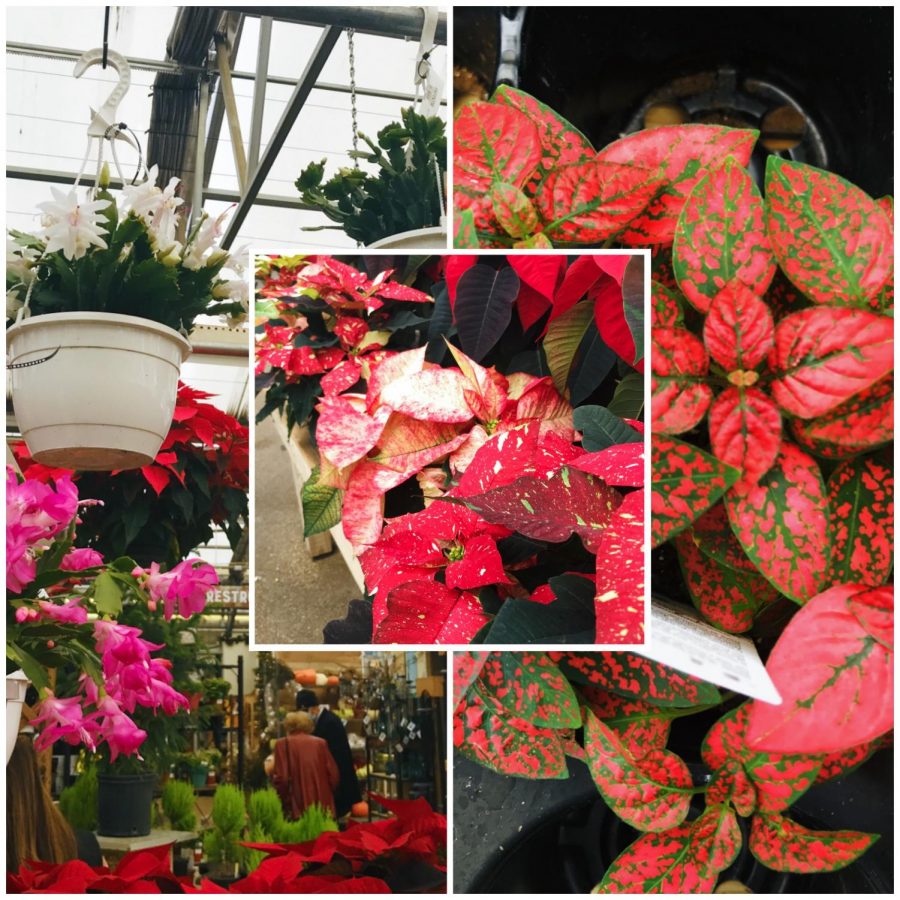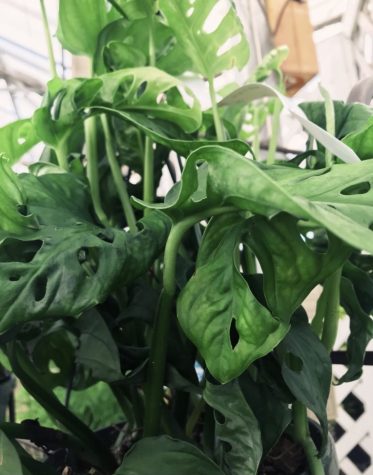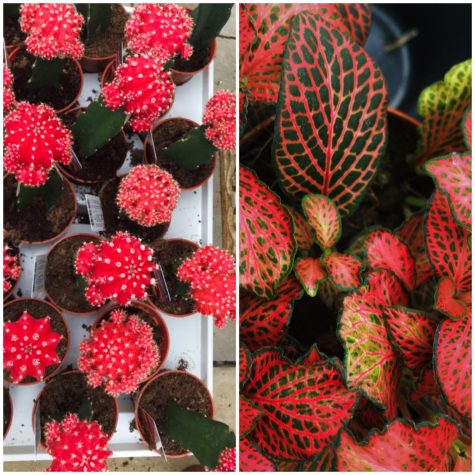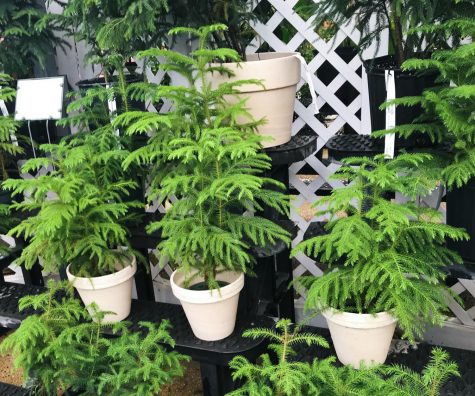The New Leaf: Holiday plants ranked (Part 3)
Left: A christmas cactus. Right: A polka dot plant. Middle: a poinsettia.
#3: Poinsettia
A strong favorite, these gorgeous flowering plants make beautiful decor during the holiday season. To some, they must just seem like your grandmother’s plant, but I stand by the fact that there’s a poinsettia for everyone. Native to Mexico and Guatemala, these plants are one of my personal favorites. Even when it is not hot cocoa weather, they can be kept all year round.
A shockingly common myth is that poinsettias are deadly to animals, which may detract some from wanting to purchase them. However, according to the American Society for the Prevention of Cruelty to Animals, if ingested by dogs and cats, only may cause irritation to the mouth and stomach. Although accompanied by occasional vomiting, they overrated in their toxicity to pets. As long as you keep them in a safe spot, your pets should remain safe. According to the University of Minnesota’s extension website, these plants should ideally be kept in temperatures around 65 to 70 degrees Fahrenheit, no lower than 50 degrees Fahrenheit. Freezing temperatures kill poinsettias, so unless you live in a frost free zone, keep your plant inside during the winter. Poinsettias should be placed in areas where the temperature likely won’t fluctuate, so not near heaters or vents. Their watering schedule is also not too difficult for non-plant aficionados, as they should be kept in moist soil, and watered when the soil is dried out. However, they should also not sit in water, as that could lead to root rot.
Their spelling is not the only deceiving part of this plant! Interestingly enough, the bright pigments on poinsettias that they are known for are not actually flowers. They are bracts, or brightly colored leaves, while the flowers rest in the center of the poinsettia. After the holiday season, the bracts will begin to fall off, and the poinsettia will turn plain green. This is perfect for the rest of the year, as a bright red, flowery plant may not feel the most appropriate in June.
Getting your poinsettia to bloom again, however, can be a bit of a challenge. Fertilizing, while a pain, will be necessary for this. You should aim at fertilizing every 3-4 weeks after December. Mix the fertilizer with water at half the recommended strength. Continue to do this and follow all routine care instructions (with some adjustments that you can research at https://extension.umn.edu/houseplants/poinsettia#transplanting-1579963). Until early September, you should reduce the fertilizer to just one quarter of the recommended strength. Once it is around the fall equinox, or September 21, you should place your poinsettia in an area where they will receive at least 16 hours of uninterrupted darkness, such as in a dark closet or under a box. The plant should not receive any light during this time, and should continue to be fertilized at one quarter of the recommended rate. Once it reaches Thanksgiving, the plant should then be placed in a sunny area, and watering and fertilizing should be reduced. Then, by the holidays, you should be good-to-go with your newly bloomed and colorful poinsettia!
Overall, these plants may seem a little tricky if you intend to keep them year round, but if you’re just looking for a nice plant over the holidays, then they are near perfect. Depending on the size, they can range anywhere from five to 40 dollars (very budget friendly), and some even come in self-watering pots! They also come in a variety of colors and patterns with fun names such as jingle bells, classic red, polly’s pink, strawberries and cream and polar bear, to name a few. There truly is a Poinsettia for everyone! I myself have not yet purchased one, but likely will end up getting a larger jingle bell Poinsettia for my mom and a smaller one for my room. Take a trip to your local garden center, such as Merrifield, and ask a plant specialist to Poinsettia you in the right direction of this spectacular plant.
#2: Christmas Cactus
This classic Christmas plant may be one we all know and maybe not love, but I’m here to tell you just why you should love this spunky plant. Coming in a variety of colors, such as pink, white, red, fuschia, yellow, orange and red, this plant is easy to propagate and give to others. The cactus is also known as the Thanksgiving or Easter Cactus, so it applies to many holidays! In my opinion, it should just be known as the Holiday Cactus. That way even more people would buy these great plants. And why are they so great, you ask? Because of their stunning flowers and fairly effortless care!
Native to South America, the Christmas Cactus requires indirect bright light, as well as somewhat attentive watering throughout the year. According to Gardening Know How, the cactus needs its soil kept decently moist throughout the most prominent growing seasons — summer and spring. For the rest of the year, it is good to let the plant dry out just a little bit more than previously. A pebble tray is also awesome for your Christmas Cactus, as they love humidity. To the gardening noobs out there, this is a saucer underneath the pot of a plant that is covered with pebbles that have water sitting just below them. Christmas Cacti prefer temperatures between 60 and 70 degrees Fahrenheit, so be sure not to leave your plant out in the cold.
Once the plant has eventually lost all of its gorgeous blooms, which usually occurs in the fall, in order to get it to re-bloom similarly to a Poinsettia, you must do the following. The plant should be tricked into going into dormancy, so cut back on watering and place it in a dark area for at least 12-14 hours a day for about six to eight weeks. After that time has passed, you should be good to go! Return the plant, and its stunning new blooms, to its usual location and moisture levels. You may even get some extra bloom cycles from your cactus throughout the year if you’re lucky!
This plant truly is full of surprises, so who wouldn’t appreciate one this holiday season? If you already have a Christmas Cactus of your own and don’t want to spend the money on a new one, the good news is that you can propagate it! You can do this by trimming a healthy leaf into a short Y-shape and planting it into soil, sticking about a quarter of it into the dirt. The soil should be kept evenly moist, and placed in an area with indirect sunlight. To learn about other methods, visit https://www.gardeningknowhow.com/ornamental/cacti-succulents/christmas-cactus/advice-for-christmas-cactus-care.htm!
As you can tell, a Christmas Cactus really is the perfect gift this holiday season. The beautiful flowers last year round and are non-toxic to animals, which is great for pet lovers. Christmas Cacti can range anywhere from five to 40 dollars, so they are ideal for a student on a budget. I’m planning on purchasing one myself this year and cannot wait to add it to my collection. You should flower – I mean follow – in my footsteps and get yourself one of these stunning guys today!
#1: Polka Dot Plant
I cannot recommend polka dot plants enough. I recently purchased one in the pink, white, and red variety and already adore it. Its colorful spots and gorgeous leaves are a total showstopper, and this guy is by far the prettiest plant in my room (no offense to my other plants, of course). Many may not consider it a holiday plant, but hopefully the photo above of the red and green variation changes your mind. Not only is this coloring perfect for the holidays, it is great all year round.
Native to Madagascar, this plant likes moist soil, and should not go completely dry. Be sure not to drench your plant and cause it to have waterlogged soil, however, as that will lead to root rot (and no one wants that)! Polka dot plants like bright but indirect light, and according to Gardening Know How, should not be kept in temperatures below 60 degrees Fahrenheit, so don’t go sticking your plant outside in the cold. You will not believe me, but that is pretty much it for its care! All that you have to do to keep this plant alive is laid out in three sentences.
Along with being so simple to care for that they are the shortest section of this blog post, polka dot plants also are non-toxic to dogs and cats. Really, how much more simple and perfect could this get?! Maybe the Moon Cactus is a tad easier to care for, but this plant is still my number one recommendation. These guys can be purchased for as low as six dollars, so they are perfect for someone on a budget during the holidays. If you still do not want the polka dot plant after reading this, go polka yourself (ha).







Gretchen Masion • Jan 16, 2021 at 1:31 PM
Great information! Very well-written and detailed! Hypoestes, commonly called Polka Dot Plant, is a great plant for beginners and comes in red, green and pink varieties. I never thought of it as a holiday plant but now I do! My daughter is a Junior at JMU and it’s one of only two plants she owns becasue it’s so easy to keep happy!